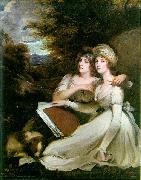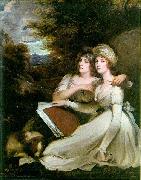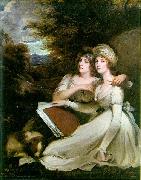Wholesale Oil Painting No Minimum |
|||||||||||
|
|
|||||||||||

|
|||||||||||
|
|
|
||||||||
John Hoppner1758-1810 British John Hoppner Galleries John Hoppner (April 4?, 1758 - January 23, 1810), English portrait-painter, was born in Whitechapel. His father was of German extraction, and his mother was one of the German attendants at the royal palace. Hoppner was consequently brought early under the notice and received the patronage of George III, whose regard for him gave rise to unfounded scandal. As a boy he was a chorister at the royal chapel, but showing strong inclination for art, he in 1775 entered as a student at the Royal Academy. In 1778 he took a silver medal for drawing from the life, and in 1782 the Academy's highest award, the gold medal for historical painting, his subject being King Lear. He first exhibited at the Royal Academy In 1780. His earliest love was for landscape, but necessity obliged him to turn to the more lucrative business of portrait painting. At once successful, he had throughout life the most fashionable and wealthy sitters, and was the greatest rival of the growing attraction of Lawrence. Ideal subjects were very rarely at tempted by Hoppner, though a "Sleeping Venus," "Belisarius," "Jupiter and Io," a "Bacchante" and "Cupid and Psyche" are mentioned among his works. The prince of Wales visited him especially often, and many of his finest portraits are in the state apartments at St. James's Palace, the best perhaps being those of the prince, the duke and duchess of York, of Lord Rodney and of Lord Nelson, Among his other sitters were Sir Walter Scott, the Duke of Wellington, Frere and Sir George Beaumont. Competent judges have deemed his most successful works to be his portraits of women and children. A Series of Portraits of Ladies was published by him in 1803, and a volume of translations of Eastern tales into English verse in 1805. The verse is of but mediocre quality. In his later years Hoppner suffered from a chronic disease of the liver. He was confessedly an imitator of Reynolds. When first painted, his works were much admired for the brilliancy and harmony of their colouring, but the injury due to destructive mediums and lapse of time which many of them suffered caused a great depreciation in his reputation. The appearance, however, of some of his pictures in good condition has shown that his fame as a brilliant colourist was well founded. His drawing is faulty, but his touch has qualities of breadth and freedom that give to his paintings a faint reflection of the charm of Reynolds. Hoppner was a man of great social power, and had the knowledge and accomplishments of a man of the world. The best account of Hoppner's life and paintings is the exhaustive work by William McKay and W Roberts (1909 |
||||||||
|
|
||||||||
Portrait of the Frankland Sisters
Portrait of the Frankland Sisters Painting ID:: 68540 |
Technique Oil on canvas Technique Oil on canvas |
|||||||
|
|
||||||||
John Hoppner1758-1810 British John Hoppner Galleries John Hoppner (April 4?, 1758 - January 23, 1810), English portrait-painter, was born in Whitechapel. His father was of German extraction, and his mother was one of the German attendants at the royal palace. Hoppner was consequently brought early under the notice and received the patronage of George III, whose regard for him gave rise to unfounded scandal. As a boy he was a chorister at the royal chapel, but showing strong inclination for art, he in 1775 entered as a student at the Royal Academy. In 1778 he took a silver medal for drawing from the life, and in 1782 the Academy's highest award, the gold medal for historical painting, his subject being King Lear. He first exhibited at the Royal Academy In 1780. His earliest love was for landscape, but necessity obliged him to turn to the more lucrative business of portrait painting. At once successful, he had throughout life the most fashionable and wealthy sitters, and was the greatest rival of the growing attraction of Lawrence. Ideal subjects were very rarely at tempted by Hoppner, though a "Sleeping Venus," "Belisarius," "Jupiter and Io," a "Bacchante" and "Cupid and Psyche" are mentioned among his works. The prince of Wales visited him especially often, and many of his finest portraits are in the state apartments at St. James's Palace, the best perhaps being those of the prince, the duke and duchess of York, of Lord Rodney and of Lord Nelson, Among his other sitters were Sir Walter Scott, the Duke of Wellington, Frere and Sir George Beaumont. Competent judges have deemed his most successful works to be his portraits of women and children. A Series of Portraits of Ladies was published by him in 1803, and a volume of translations of Eastern tales into English verse in 1805. The verse is of but mediocre quality. In his later years Hoppner suffered from a chronic disease of the liver. He was confessedly an imitator of Reynolds. When first painted, his works were much admired for the brilliancy and harmony of their colouring, but the injury due to destructive mediums and lapse of time which many of them suffered caused a great depreciation in his reputation. The appearance, however, of some of his pictures in good condition has shown that his fame as a brilliant colourist was well founded. His drawing is faulty, but his touch has qualities of breadth and freedom that give to his paintings a faint reflection of the charm of Reynolds. Hoppner was a man of great social power, and had the knowledge and accomplishments of a man of the world. The best account of Hoppner's life and paintings is the exhaustive work by William McKay and W Roberts (1909 |
||||||||
|
|
||||||||
|
|
Portrait of the Frankland Sisters
Portrait of the Frankland Sisters Painting ID:: 76615 |
1795(1795)
Oil on canvas
155 ?? 125 cm (61 ?? 49.2 in)
cjr 1795(1795) Oil on canvas 155 ?? 125 cm (61 ?? 49.2 in) cjr |
||||||
|
|
||||||||
John Hoppner1758-1810 British John Hoppner Galleries John Hoppner (April 4?, 1758 - January 23, 1810), English portrait-painter, was born in Whitechapel. His father was of German extraction, and his mother was one of the German attendants at the royal palace. Hoppner was consequently brought early under the notice and received the patronage of George III, whose regard for him gave rise to unfounded scandal. As a boy he was a chorister at the royal chapel, but showing strong inclination for art, he in 1775 entered as a student at the Royal Academy. In 1778 he took a silver medal for drawing from the life, and in 1782 the Academy's highest award, the gold medal for historical painting, his subject being King Lear. He first exhibited at the Royal Academy In 1780. His earliest love was for landscape, but necessity obliged him to turn to the more lucrative business of portrait painting. At once successful, he had throughout life the most fashionable and wealthy sitters, and was the greatest rival of the growing attraction of Lawrence. Ideal subjects were very rarely at tempted by Hoppner, though a "Sleeping Venus," "Belisarius," "Jupiter and Io," a "Bacchante" and "Cupid and Psyche" are mentioned among his works. The prince of Wales visited him especially often, and many of his finest portraits are in the state apartments at St. James's Palace, the best perhaps being those of the prince, the duke and duchess of York, of Lord Rodney and of Lord Nelson, Among his other sitters were Sir Walter Scott, the Duke of Wellington, Frere and Sir George Beaumont. Competent judges have deemed his most successful works to be his portraits of women and children. A Series of Portraits of Ladies was published by him in 1803, and a volume of translations of Eastern tales into English verse in 1805. The verse is of but mediocre quality. In his later years Hoppner suffered from a chronic disease of the liver. He was confessedly an imitator of Reynolds. When first painted, his works were much admired for the brilliancy and harmony of their colouring, but the injury due to destructive mediums and lapse of time which many of them suffered caused a great depreciation in his reputation. The appearance, however, of some of his pictures in good condition has shown that his fame as a brilliant colourist was well founded. His drawing is faulty, but his touch has qualities of breadth and freedom that give to his paintings a faint reflection of the charm of Reynolds. Hoppner was a man of great social power, and had the knowledge and accomplishments of a man of the world. The best account of Hoppner's life and paintings is the exhaustive work by William McKay and W Roberts (1909 |
||||||||
|
|
||||||||
|
|
Portrait of the Frankland Sisters
Portrait of the Frankland Sisters Painting ID:: 78481 |
1795(1795)
Medium Oil on canvas
Dimensions 155 x 125 cm (61 x 49.2 in)
cyf 1795(1795) Medium Oil on canvas Dimensions 155 x 125 cm (61 x 49.2 in) cyf |
||||||
|
|
||||||||
|
John Hoppner 1758-1810 British John Hoppner Galleries John Hoppner (April 4?, 1758 - January 23, 1810), English portrait-painter, was born in Whitechapel. His father was of German extraction, and his mother was one of the German attendants at the royal palace. Hoppner was consequently brought early under the notice and received the patronage of George III, whose regard for him gave rise to unfounded scandal. As a boy he was a chorister at the royal chapel, but showing strong inclination for art, he in 1775 entered as a student at the Royal Academy. In 1778 he took a silver medal for drawing from the life, and in 1782 the Academy's highest award, the gold medal for historical painting, his subject being King Lear. He first exhibited at the Royal Academy In 1780. His earliest love was for landscape, but necessity obliged him to turn to the more lucrative business of portrait painting. At once successful, he had throughout life the most fashionable and wealthy sitters, and was the greatest rival of the growing attraction of Lawrence. Ideal subjects were very rarely at tempted by Hoppner, though a "Sleeping Venus," "Belisarius," "Jupiter and Io," a "Bacchante" and "Cupid and Psyche" are mentioned among his works. The prince of Wales visited him especially often, and many of his finest portraits are in the state apartments at St. James's Palace, the best perhaps being those of the prince, the duke and duchess of York, of Lord Rodney and of Lord Nelson, Among his other sitters were Sir Walter Scott, the Duke of Wellington, Frere and Sir George Beaumont. Competent judges have deemed his most successful works to be his portraits of women and children. A Series of Portraits of Ladies was published by him in 1803, and a volume of translations of Eastern tales into English verse in 1805. The verse is of but mediocre quality. In his later years Hoppner suffered from a chronic disease of the liver. He was confessedly an imitator of Reynolds. When first painted, his works were much admired for the brilliancy and harmony of their colouring, but the injury due to destructive mediums and lapse of time which many of them suffered caused a great depreciation in his reputation. The appearance, however, of some of his pictures in good condition has shown that his fame as a brilliant colourist was well founded. His drawing is faulty, but his touch has qualities of breadth and freedom that give to his paintings a faint reflection of the charm of Reynolds. Hoppner was a man of great social power, and had the knowledge and accomplishments of a man of the world. The best account of Hoppner's life and paintings is the exhaustive work by William McKay and W Roberts (1909 Portrait of the Frankland Sisters 1795(1795) Medium Oil on canvas Dimensions 155 x 125 cm (61 x 49.2 in) cyf |
||||||||
|
|
||||||||
|
Prev Next
|
||||||||
|
|
||||||||
|
Related Paintings to John Hoppner :. |
||||||||
|
|
||||||||
|
CONTACT US |



